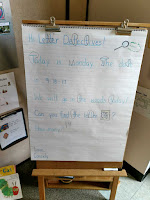When you find yourself out of the green zone,
what do you do to get yourself back in the green zone?
IM - "I was feeling sad this morning, because I wanted to pick my own clothes. But, then I came to school. I just came to school and now it's okay"
CS - "It sounds like having time helped to get in the green zone. I often find that when I give myself time, I begin to feel better"
ZM - "I was in the blue zone this morning. I was so tired. I wanted to keep sleeping, so I said to my dad, one more minute. I had one more minute and then - I got up!"
CS - "So, I'm hearing that you made a plan with dad - having one more minute to rest helped you to get up and start your day"


Some children used the message as a tool for writing or labeling the zone they were representing;

Next Steps;
I will take their drawings and writing and put it into a book about the zones. It will be our third book that we've made this year! I find books to be a powerful way to document an experience as well as a rich means for revisiting. It is empowering for the children to see their work cared for and shared. Their writing, drawing, and ideas are important. Our work will also be used to connect to future teaching. In the writing unit we use, there is a focus on writing How To Books. As the Kindergarteners become experts on naming zones and feelings as well as strategies for being in the green zone, how authentic for them to write a book about How To Be in the Green Zone! This book could then be shared with future Kindergarteners or across classrooms. Of course, these are connections and dreams that go through my mind. The authentic and meaningful learning will come from the children - I will support and help scaffold the paths they choose.















































